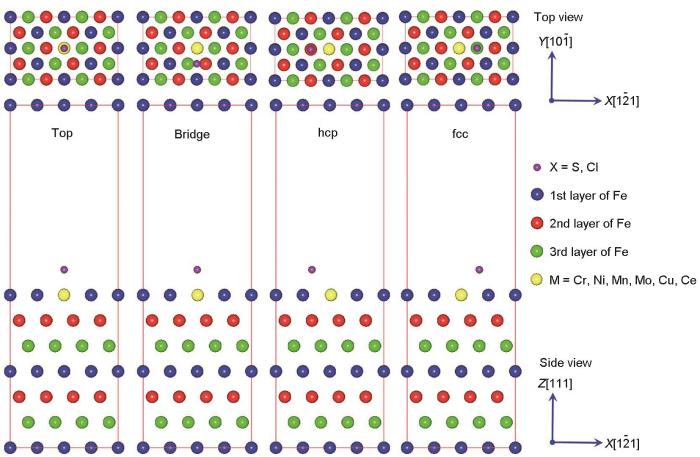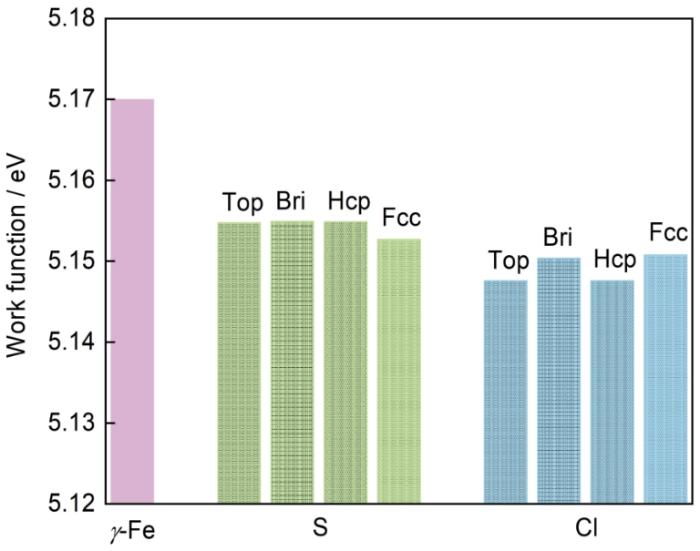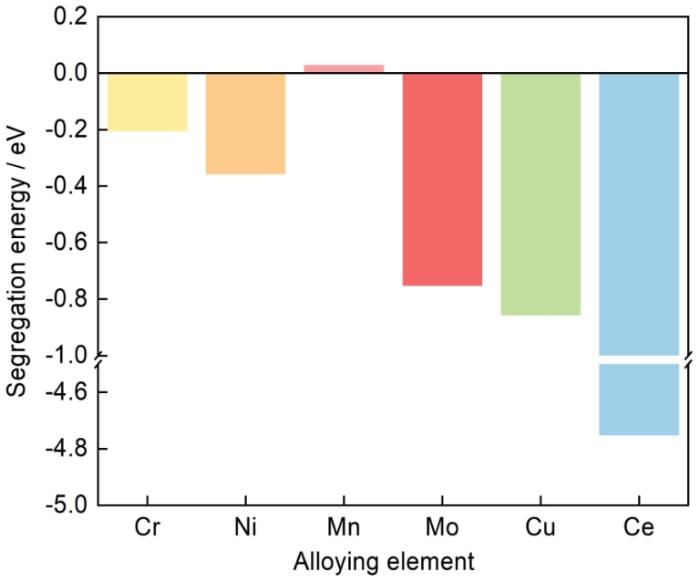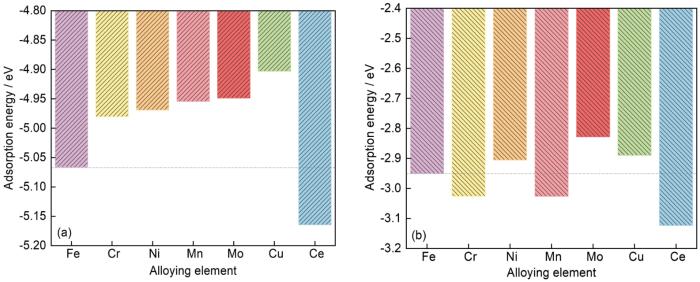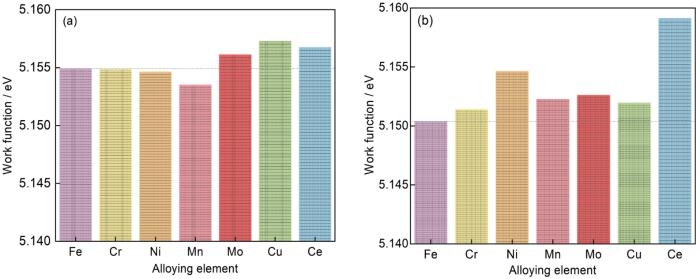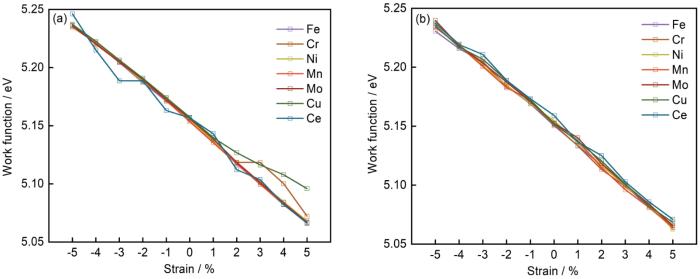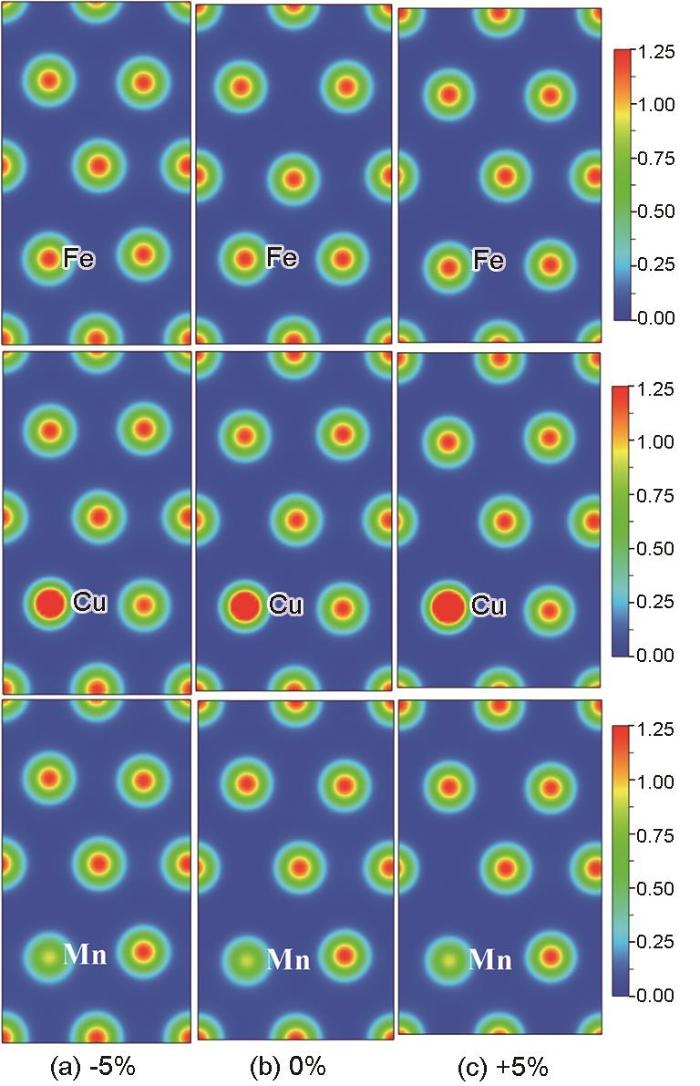为了避免腐蚀对不锈钢造成的损害,延长其服役时间,奥氏体不锈钢中往往加入多种合金元素来提高抗腐蚀性能。如Cr会使不锈钢中Fe的电极电位显著提高,同时在表面生成钝化膜,极大的减弱腐蚀[5]。Ni通过促进奥氏体的形成进而提高其耐蚀性能[6]。Mn增加奥氏体的稳定性,但会降低其耐蚀性[7]。Mo的加入则提高抗晶间腐蚀的能力[8]。Cu可以提高耐点蚀和缝隙腐蚀的能力[9]。对于稀土Ce来说,它是钢中优良的脱氧脱硫剂,能净化晶界、细化晶粒、改性夹杂物,提高耐蚀性和抗高温氧化性等[10~12]。目前,合金化方法对于提高不锈钢耐蚀性有很多研究,尤其是合金化元素耐S、Cl环境的腐蚀研究,2205、2507双相不锈钢具有更高的抗海水中Cl腐蚀的能力,S31254超级奥氏体不锈钢就是针对含有S、Cl腐蚀介质的极端腐蚀环境而设计的[13, 14],耐蚀性的提高离不开上述合金化元素的作用。S、Cl对不锈钢的腐蚀是其吸附于不锈钢表面产生的,S、Cl吸附于不锈钢表面体系的稳定性及耐蚀性,尤其合金化元素对S、Cl吸附于奥氏体表面体系稳定性和耐蚀性的影响至关重要,但目前从理论方面特别是从电子结构层次的研究却少有报道。
1 计算方法与结构模型
1.1 计算方法
本文计算使用基于密度泛函理论的VASP软件,采用平面投影缀加波(PAW)方法处理原子核和价电子间的相互作用,交换关联函选用GGA-PBE。优化过程中,平面波截断能为400 eV,布里渊区K点设置为9 × 6 × 1。结构优化的收敛精度为:自洽场迭代的力收敛阈值为10-5 eV,作用于每个原子上的力不大于0.3 eV/nm内应力不大于0.05 GPa。当收敛参数同时满足时,结构弛豫完成。由于针对无磁性的奥氏体不锈钢,故计算过程中没有考虑磁性的影响[17]。计算表面功函数时添加输入参数LVTOT =.TRUE.。
1.2 结构模型
本文研究奥氏体不锈钢表面的腐蚀行为,因此通过构建具有fcc结构的γ-Fe的最密排面(111)面作为研究对象。搭建表面结构前,首先对fcc结构的Fe单胞进行结构优化,得到的Fe单胞的晶格常数为0.348 nm,与其他学者的计算结果0.345 nm[18]和0.343 nm[19]非常相近,说明当前的计算参数选择合理。考虑到理论计算的精度和效率的统一,进行了纯γ-Fe(111)表面层数的收敛性测试,结果表明具有7层结构的γ-Fe(111)表面模型足以模拟实际的Fe(111)面原子排列情况,因此搭建了含7层共56个Fe原子,真空层厚度为2 nm的结构模型,以避免周期性对表面原子的干扰。优化过程中底部的4个原子层为固定的原子层以模拟基体内部,表面3层原子充分的结构弛豫。基于上述结构,计算得到的Fe(111)的表面能为3.18 J/m2,与其他理论结果(2.83 J/m2 [20]和3.42 J/m2 [21])相符合,表明计算的可靠性。为了确定腐蚀介质S、Cl在γ-Fe(111)表面的最优吸附位点,选择了4个吸附位置,分别是顶位(top site):直接吸附在表面Fe原子的正上方;桥位(bridge site):吸附在表面两个Fe原子中间的上方;hcp位:吸附在表层3个Fe原子构成的倒三角形正中心的上方;fcc位:吸附在表层3个Fe原子构成的正三角形正中心的上方。初始吸附高度为0.2 nm[22],各吸附位置的顶视图和侧视图如图1所示。
图1
图1
γ-Fe(111)表面吸附S、Cl原子不同吸附位点的模型图
Fig.1
Surface structures of γ-Fe(111) adsorbed by S, Cl atoms at different sites
研究合金化对腐蚀介质S、Cl在γ-Fe(111)表面吸附后互作用影响时,首先搭建了合金元素(Cr、Ni、Mn、Mo、Cu、Ce)在γ-Fe(111)表面模型中表层和基体(第4层)位置两种模型,以确定合金元素在表面结构的占位情况。随后分别用不同合金原子替换表面模型最表层、靠近S、Cl位置处的同一个Fe原子,形成γ-FeM(111) (M = Cr、Ni、Mn、Mo、Cu、Ce)表面,合金原子位置如图1所示。研究应力对腐蚀介质S、Cl作用下γ-Fe(111)表面腐蚀影响时,采用1.0%为应变步长,在γ-Fe(111)表面的X方向上施加应变量从-5.0%到5.0%,研究施加拉、压应力对表面结构的耐蚀性影响。
2 结果与讨论
2.1 S、Cl在 γ-Fe(111)表面吸附后互作用分析
首先对S、Cl在γ-Fe(111)表面的吸附行为进行研究,主要计算S、Cl在γ-Fe(111)表面4种吸附位点体系的吸附能,以确定其在表面的最优吸附位点,吸附能[23]的计算公式如下:
式中,
S、Cl在γ-Fe(111)表面4种不同吸附位置处的吸附能及每种吸附位置优化后最终吸附位点如表1所示。对于腐蚀介质S来说,top位和bridge位不稳定,优化后S吸附能最低的位置在hcp位置,吸附能为-5.066 eV,其次是fcc位置。此外,对于同一吸附体系,其吸附高度的大小也在一定程度上反映出吸附的稳定性,吸附高度越小,吸附物质与表面的距离越近,相互作用越强[24]。从S到表面的吸附高度来看,hcp位置的吸附高度为0.160 nm,是4种吸附位点中最小的,表明hcp位是S在γ-Fe(111)表面的最优吸附位点。类似地,Cl在top位和bridge位不稳定,吸附能最低的位置出现在fcc位置,此时吸附能为-2.950 eV,Cl距离表面的吸附高度最小为0.182 nm,表明fcc位是Cl在γ-Fe(111)表面的最优吸附位点。
表1 S、Cl在γ-Fe(111)表面4种吸附位置处的吸附能及每种吸附位置优化后的结构
Table 1
| Adatom | Initial configuration | Final configuration | Adsorption height / nm | Adsorption energies / eV |
|---|---|---|---|---|
| S | top | hcp | 0.160 | -5.066 |
| bridge | hcp | 0.160 | -5.066 | |
| hcp | hcp | 0.160 | -5.066 | |
| fcc | fcc | 0.170 | -4.927 | |
| Cl | top | hcp | 0.184 | -2.912 |
| bridge | fcc | 0.181 | -2.950 | |
| hcp | hcp | 0.184 | -2.912 | |
| fcc | fcc | 0.181 | -2.947 |
图2
图2
S、Cl在γ-Fe (111)表面的电子功函数
Fig.2
Electronic work functions of S and Cl on γ-Fe(111)
2.2 S、Cl在 γ-FeM(111) (M = Cr、Ni、Mn、Mo、Cu、Ce)表面吸附后互作用分析
合金元素Cr、Ni、Mn、Mo、Cu、Ce对S、Cl吸附于γ-Fe(111)表面的稳定性影响明显,下面分析合金元素在γ-Fe(111)表面的偏聚行为,以确定其在表面结构中的最稳定占位。对合金元素在表面的偏析能进行计算,计算公式如下式[28]:
其中,
图3
图3
合金元素在γ-Fe (111)表面处的偏析能
Fig.3
Calculated segregation energies of alloying atoms on γ-Fe (111)
合金化后,S、Cl在γ-FeM(111) (M = Cr、Ni、Mn、Mo、Cu、Ce)表面的最优吸附位点没有发生变化,S的吸附位点仍为hcp位,Cl的吸附位点是fcc位。图4所示为S、Cl在γ-FeM(111)表面最优吸附位点吸附后各体系的吸附能值。可以看出,对于腐蚀介质S,合金化后,吸附能大小顺序为:Ce < Fe < Cr < Ni < Mn < Mo < Cu。合金元素Cr、Ni、Mn、Mo、Cu使得体系的吸附能值增大,抑制了表面腐蚀介质S的吸附,使得S与γ-Fe(111)表面的作用力减弱;而合金元素Ce使得吸附能值减小,即使得S更易于吸附,S与γ-Fe(111)表面的作用力更强。Cl吸附时,合金元素Ni、Mo、Cu使得体系的吸附能值增大,抑制了Cl在表面的吸附,Cl与γ-Fe(111)表面的作用力减弱;而合金元素Cr、Mn、Ce使得吸附能值减小,即使得Cl更容易吸附,Cl与表面的作用力增强。
图4
图4
S、Cl在γ-FeM(111) (M = Cr、Ni、Mn、Mo、Cu、Ce)表面的吸附能
Fig.4
Adsorption energies of S (a) and Cl (b) on γ-FeM(111) (M = Cr, Ni, Mn, Mo, Cu, Ce)
图5所示为S、Cl在γ-FeM(111) (M = Cr、Ni、Mn、Mo、Cu、Ce)表面吸附后的电子功函数。对于腐蚀介质S来说,合金化后,合金元素Mo、Cu、Ce使得表面电子功函数值增大,说明Mo、Cu、Ce合金化后使得表面耐S腐蚀能力提高;Cr和Ni合金化对于吸附S表面的电子功函数影响较小,对表面耐S腐蚀性能影响很小;Mn元素合金化后表面电子功函数值减小,表面耐S腐蚀性能减弱。腐蚀介质Cl体系中,合金元素Cr、Ni、Mn、Mo、Cu、Ce合金化均使得表面体系的电子功函数值增大,提高了表面耐Cl腐蚀性能。整体来看,Mo、Cu和Ce可以同步提高γ-Fe(111)表面的抗S、Cl腐蚀能力。
图5
图5
S、Cl在γ-FeM(111)(M = Cr、Ni、Mn、Mo、Cu、Ce)表面的电子功函数
Fig.5
Electronic work functions of S (a) and Cl (b) on γ-FeM(111)(M = Cr, Ni, Mn, Mo, Cu, Ce)
2.3 应力对S、Cl在 γ-FeM(111) (M = Cr、Ni、Mn、Mo、Cu、Ce)表面腐蚀行为影响
应力状态下,材料表面施加应力会使得表层原子结构发生变化,表面电子功函数也会相应发生变化,而应力类型、大小和方向均会引起不同的腐蚀效果。图6列出了拉、压应力(负号和正号分别表示压缩应变和拉伸应变)作用下,S、Cl在γ-FeM(111) (M = Cr、Ni、Mn、Mo、Cu、Ce)表面电子功函数变化情况。整体来看,表面在压应力作用下,电子功函数增大,材料表面耐蚀性提升;当表面受到拉应力作用时,表面电子功函数减小,材料耐蚀性降低。这也与其他学者的研究结果相符[29],拉应力使得原子之间距离增大,电荷密度减小,进而使得电子功函数变小。表面合金化后,压应力作用下,表面电子功函数提高;拉应力作用下,电子功函数降低。不同合金元素体系对比来看,Cu和Mo合金化体系材料表面电子功函数更大,对应的材料表面耐蚀性更强。
图6
图6
应变对S、Cl在γ-FeM(111) (M = Cr、Ni、Mn、Mo、Cu、Ce)表面电子功函数的影响
Fig.6
Effects of strain on electronic work functions of S (a) and Cl (b) on γ-FeM(111) (M = Cr, Ni, Mn, Mo, Cu, Ce)
为了进一步表征拉、压应力作用下S、Cl在不同合金化γ-Fe(111)表面吸附后表面结构的差异,以未吸附γ-Fe(111)表面、Cu合金化表面和Mn合金化表面为代表,以S吸附体系作为研究对象,绘制了S吸附的γ-Fe(111)表面、Cu合金化表面和Mn合金化表面在-5%,0%,+5%应变下的电荷密度图,如图7所示。从图中可看出,应力的作用使得表层电子重新分布,压应力作用下,表面原子之间电荷密度增加,原子之间相互作用增强,导致金属中的电子从表面溢出更加困难,电子功函数增大;而拉应力作用下,表面原子之间电荷密度减小,原子之间相互作用减弱,表面电子功函数降低。不同合金化表面相比,Cu合金化后,Cu和周围Fe原子之间电荷密度增加,原子之间结合增强,使得表面电子功函数增加;而Mn合金化后,Mn和周围Fe原子之间电荷密度减小,电子功函数降低。
图7
图7
不同应变下S在合金化表面的表面电荷密度图
Fig.7
Charge densities of S on γ-Fe(111) and γ-FeM(111) (M = Cu and Mn) under the different strains of -5% (a), 0% (b) and +5% (c)
3 结论
(1) 腐蚀介质S、Cl在γ-Fe(111)表面最优吸附位点分别为hcp位和fcc位,S和Cl吸附表面电子功函数降低,耐蚀性减弱。
(2) 合金元素Cr、Ni、Mo、Cu、Ce易在γ-Fe表面偏析;Cr、Ni、Mn、Mo、Cu可以有效抑制S在γ-Fe(111)表面的吸附,使得S与γ-Fe表面作用力减弱;Ni、Mo、Cu可以抑制Cl的吸附,减弱Cl与γ-Fe表面作用力。
(3) 合金元素Cr、Ni、Mn、Mo、Cu、Ce与γ-Fe(111)构成的表面耐Cl腐蚀,Mo、Cu和Ce可以提高表面耐S腐蚀能力。总体看,超级奥氏体不锈钢中Mo、Cu有抗S、Cl腐蚀的能力,如若添加Ce可提升抗S、Cl腐蚀的能力。
(4) 压应力作用下,S、Cl吸附γ-FeM(111) (M = Cr、Ni、Mn、Mo、Cu、Ce)表面体系的电子功函数增大,而拉应力下使得γ-Fe表面电子功函数减小,S、Cl与拉应力共同作用将大大降低表面耐蚀性。
参考文献
Hot working characteristic of superaustenitic stainless steel 254SMO
[J].
Influence of temperature on the electrochemical and passivation behavior of 2507 super duplex stainless steel in simulated desulfurized flue gas condensates
[J].
Characterization of atomic structure of oxide films on carbon steel in simulated concrete pore solutions using EELS
[J].
Investigation of stress corrosion cracks in a UNS S32750 super duplex stainless steel
[J].
Interplay between the composition of the passive film and the corrosion resistance of citric acid‐passivated AISI 316L stainless steel
[J].
Multicomponent Ni-rich high-entropy alloy toughened with irregular-shaped precipitates and serrated grain boundaries
[J].
Corrosion, passivation and breakdown of passivity of neodymium
[J].
Role of molybdenum on the electronic properties of passive films on stainless steels
[J].
An advanced creep cavitation resistance Cu-containing 18Cr-12Ni-Nb austenitic stainless steel
[J].
Effect of Ce addition on secondary phase transformation and mechanical properties of 27Cr-7Ni hyper duplex stainless steels
[J].
Effect of rare earth element Ce on corrosion-resisting properties of austenite stainless steel 204Cu
[J].

The austenite stainless steel 204Cu (/% : 0.125-0.131C, 0.32-0.34Si, 8.51-8.73Mn, 0.002-0.006S, 0.035-0.047P, 16.40-16.64Cr, 2.53-2.72Ni, 2.33-2.38Cu, 0.257-0.271N, 0-0.064Ce) is melted by a 10 kg vacuum induction furnace, forged to 25 mm x 25 mm square billet, and solid-solution-treated at 1150 ℃ for 2 h, water cooling. The effect of 0-0.064% Ce on corrosion-resisting properties of stainless steel 204Cu in 3.5% NaCl solution at 25 ℃ has been studied by using weight method, electrochemical polarization curves and AC impedance techniques. Results show that adding definite earth element Ce in stainless steel 204Cu, the anod polarization voltage value shifts positively,the corrosion current density decreases and the polarization resistance increases, that can obviously increase its corrosion-resisting properties, as adding 0.029% Ce the stainless steel 204Cu has optimizing corrosion-resisting properties.
稀土元素Ce对204Cu奥氏体不锈钢耐腐蚀性能的影响
[J].
The roles of Ce and Mn on solidification behaviors and mechanical properties of 7mo super austenitic stainless steel
[J].
Characterization of the passive properties of 254SMO stainless steel in simulated desulfurized flue gas condensates by electrochemical analysis, XPS and ToF-SIMS
[J].
Chloride- and sulphate-induced hot corrosion mechanism of super austenitic stainless steel S31254 under dry gas environment
[J].
Modeling the influence of microstructure on the stress distributions of corrosion pits
[J].
General corrosion and stress corrosion cracking of alloy 600 in light water reactor primary coolants
[J].
Segregation behavior of alloying elements at NbC/fcc-Fe interface and effects of boron
[J].
Gradient-corrected density functional calculation of elastic constants of Fe, Co and Ni in bcc, fcc and hcp structures
[J].
Theory of bonding in transition-metal carbides and nitrides
[J].
The austenite/ɛ martensite interface: A first-principles investigation of the fcc Fe(1 1 1)/hcp Fe(0 0 0 1) system
[J].
DFT study of the effects of interstitial impurities on the resistance of Cr-doped γ-Fe(111) surface dissolution corrosion
[J].
The geometry structure and electronic states of chlorine on Cu(111) surface
[J].
氯原子在Cu(111)表面的吸附结构和电子态
[J].
Theoretical study of oxygen adsorption at the Fe(1 1 0) and (1 0 0) surfaces
[J].
Effects of different alloying elements M (M = Fe, Ni, Mn, Si, Mo, Cu, Y) on Cr2O3 with Cl: a first-principles study
[J].
Electron work function: a parameter sensitive to the adhesion behavior of crystallographic surfaces
[J].
Corrosion mechanism of T1 phase in Al-Cu-Li alloy: First-principles calculations
[J].
第一性原理研究Al-Cu-Li合金中T1相的腐蚀机理
[J].
Improved corrosion resistance of super austenite stainless steel by B-induced nucleation of Laves phase
[J].
Segregation of Cr impurities at bcc iron surfaces: First-principles calculations
[J].
Influences of tensile strain and strain rate on the electron work function of metals and alloys
[J].




